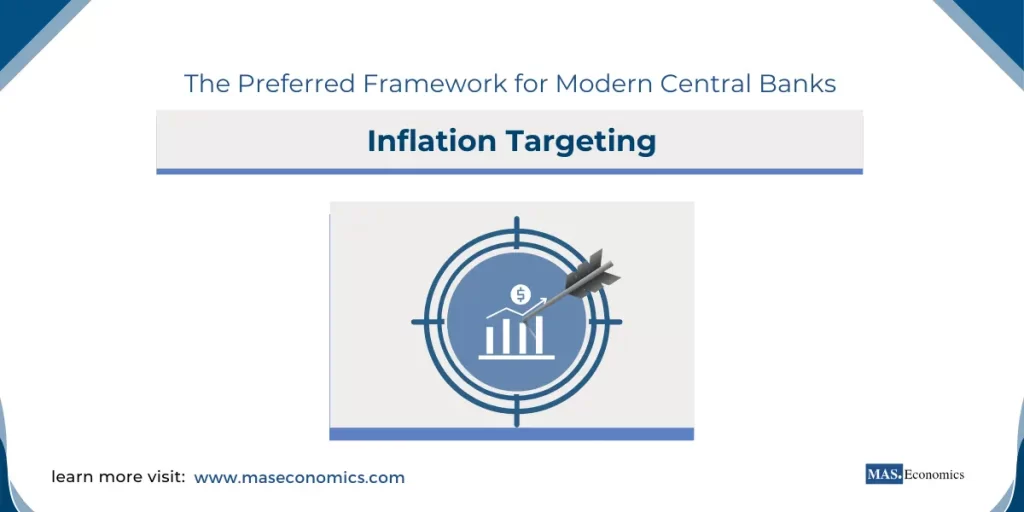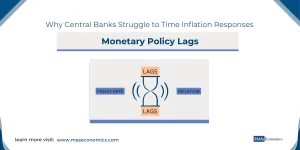Inflation targeting is one of the most widely adopted strategies for central banks worldwide. By setting an explicit inflation rate as a target, central banks create a structured approach to maintain price stability—a key goal of monetary policy. Pioneered in the 1990s, inflation targeting has gained popularity for its effectiveness in reducing inflation volatility and supporting sustainable growth.
This framework’s popularity, its operation, and its effectiveness in managing economies provide insight into the role of central banks in maintaining stability and promoting growth, even during economic turbulence.
What is Inflation Targeting?
Inflation targeting is a monetary policy strategy in which central banks announce a target or target range for inflation. Typically, this target is a medium-term goal designed to anchor inflation expectations, thereby enhancing economic predictability. The central bank uses various monetary policy tools to keep inflation close to this predetermined target, whether it’s set as a single percentage (e.g., 2%) or as a range (e.g., between 2% and 3%).
The main components of inflation targeting are:
- Publicly Announced Inflation Target: This is a numeric target or target range that the central bank commits to achieving.
- Operational Independence: The central bank must have the independence necessary to use policy instruments freely to achieve its inflation targets.
- Communication and Transparency: Inflation targeting involves clear communication about the goals of the central bank, the current stance of monetary policy, and the reasons behind each policy decision.
Why Has Inflation Targeting Become So Popular?
Clarity and Predictability
Inflation targeting provides clarity and transparency, both to the financial markets and the general public. When central banks communicate an explicit inflation target, businesses, investors, and consumers can plan for the future more effectively.
Reducing Uncertainty
People are more likely to make informed economic decisions when they understand the central bank’s inflation goals. This transparency minimizes the risk of volatile inflation expectations, which can lead to economic instability.
Managing Expectations
Anchoring inflation expectations helps prevent the self-fulfilling prophecies that often occur during periods of high inflation. When people believe the central bank will maintain low inflation, they adjust their pricing, wage demands, and spending accordingly, which helps to actually achieve low inflation.
Accountability and Credibility
Inflation targeting makes central banks more accountable by clearly establishing their objectives and making their performance measurable. If the inflation target is not met, the central bank must explain why, which builds credibility over time.
Credibility Gains
A credible central bank, one that meets its targets consistently, helps stabilize expectations. Credibility, in turn, reduces inflation premiums on interest rates, which makes borrowing cheaper and investment more viable.
Public and Political Support
With a transparent framework, inflation targeting creates a system where the public and the government can easily evaluate the central bank’s performance, thereby reducing political pressures.
How Inflation Targeting Works
Establishing the Inflation Target
Central banks and governments typically collaborate to set an inflation target. This target represents a level of inflation that is consistent with the broader economic goals of sustainable growth and employment.
Targets Are Flexible
Most central banks aim for inflation around 2% annually, though targets may vary by country. Some countries set a range to allow for flexibility when responding to unexpected economic shocks. For instance, a target of 1-3% offers room to adjust without being perceived as missing the target entirely.
Using Policy Instruments to Achieve the Target
To achieve the inflation target, central banks rely on several monetary policy tools, including:
Interest Rate Adjustments
Central banks manipulate interest rates to influence spending, borrowing, and saving. If inflation is above the target, the central bank raises interest rates to make borrowing more expensive and curb spending, which helps to lower inflation. Conversely, if inflation is too low, the central bank cuts rates to stimulate borrowing and spending.
Open Market Operations (OMOs)
Central banks buy or sell government securities to influence the money supply, which in turn affects interest rates and inflation.
Forward Guidance
By signaling the likely future path of interest rates, central banks can influence economic behavior even before making policy adjustments.
The Effectiveness of Inflation Targeting
Maintaining Price Stability
Price stability is critical for economic growth and financial health. Inflation targeting directly supports price stability by anchoring inflation expectations, which in turn reduces inflation volatility. Central banks are able to act preemptively when they anticipate inflationary pressures, rather than reacting once inflation has already set in.
Impact on Economic Growth
The ultimate goal of inflation targeting is not just low inflation but also the creation of a stable environment that fosters economic growth. Price stability minimizes the risks associated with volatile price levels, leading to a more favorable climate for businesses and individuals to plan for the future.
Supporting Employment
While inflation targeting itself does not directly target employment, it indirectly supports job creation by fostering economic conditions that are conducive to investment and expansion.
Preventing Boom and Bust Cycles
One of the most significant benefits of inflation targeting is that it helps avoid the boom-and-bust cycles that often plague economies with inconsistent or unpredictable inflation rates.
Challenges and Limitations
While inflation targeting has many advantages, it is not without challenges:
Rigidity During Supply Shocks
Supply-side shocks, such as a spike in oil prices, can present challenges for inflation-targeting regimes. Central banks must be cautious about not overly tightening the economy during such times, as this could lead to reduced growth.
Exclusivity on Inflation
Focusing solely on inflation can lead to overlooking other economic indicators, such as asset bubbles or excessive levels of debt. The 2008 financial crisis was partly attributed to the failure of central banks to consider the dangers of a rising asset bubble while focusing exclusively on inflation targets.
Communication Challenges
The success of inflation targeting hinges on effective communication. Miscommunication can create confusion and undermine the credibility of the central bank.
Historical Examples of Inflation Targeting
Success Stories: New Zealand and the UK
New Zealand was the first country to adopt inflation targeting in 1990. By the mid-1990s, the country had successfully brought inflation down to within the target range, demonstrating that setting explicit goals could influence public expectations and behavior.
The United Kingdom followed with inflation targeting in 1992. The approach has played a significant role in reducing inflation rates in the UK, helping to foster economic stability and growth during periods of global financial uncertainty.
Mixed Results: The Case of South Africa
In South Africa, inflation targeting has been less straightforward. External factors, such as commodity price volatility and exchange rate pressures, have sometimes made it difficult for the South African Reserve Bank to consistently achieve its inflation target. Despite these challenges, inflation targeting has still served as a valuable guide for policymakers, offering a consistent framework for economic management.
Is Inflation Targeting Still the Best Approach?
Alternatives to Inflation Targeting
While inflation targeting remains popular, some economists have questioned whether it should remain the dominant approach, especially given the challenges that emerged after the 2008 financial crisis. Alternatives to inflation targeting include:
Nominal GDP Targeting
Rather than focusing solely on inflation, this approach sets targets for the overall level of nominal GDP. Proponents argue that targeting GDP growth provides a broader view of economic health.
Price Level Targeting
Unlike inflation targeting, which focuses on the rate of price change, price level targeting aims to keep the price level stable over the long term. This approach could, in theory, help correct past deviations from the target more effectively.
Balancing Flexibility and Credibility
One major criticism of inflation targeting is its perceived rigidity. In practice, many central banks use a flexible version of inflation targeting, which allows them to adjust their approach to accommodate economic shocks without entirely abandoning their targets.
The success of this framework often depends on striking a balance between maintaining the credibility of the inflation target and retaining the flexibility needed to respond to shocks.
Conclusion
Inflation targeting has become a central feature of modern monetary policy frameworks, offering a clear, structured, and accountable approach to managing price stability. By providing a consistent and predictable path for inflation, it has helped anchor expectations and create an environment conducive to sustainable growth. However, like any policy tool, it has its challenges and must be applied with careful consideration of evolving economic dynamics.
The coming decade will be crucial for central banks as they face global financial integration, rapid technological change, and emerging risks like climate-related shocks. Whether inflation targeting remains the preferred approach will depend on its ability to adapt and evolve with these challenges.”
FAQs:
What is inflation targeting?
Inflation targeting is a monetary policy strategy where central banks set a clear inflation target or target range, usually for the medium term, to anchor public expectations and achieve price stability. This target guides the central bank’s use of tools like interest rates and open market operations to maintain inflation near the specified level.
Why do central banks prefer inflation targeting?
Central banks favor inflation targeting because it provides clarity, predictability, and transparency, helping businesses, investors, and the public make better economic decisions. It also enhances the credibility and accountability of central banks by setting a clear, measurable goal that helps manage inflation expectations and prevent volatility.
How does inflation targeting work in practice?
To achieve the target, central banks adjust interest rates and may use other tools like open market operations. If inflation is high, they raise interest rates to curb spending and borrowing. If inflation is low, they cut rates to stimulate economic activity. Central banks also provide forward guidance, signaling their future policy direction to shape expectations.
What are the benefits of inflation targeting?
The benefits of inflation targeting include reduced inflation volatility, clearer communication of policy goals, and improved credibility of central banks. By anchoring expectations, it helps prevent erratic price changes, which contributes to economic stability, supports investment, and indirectly promotes employment.
Are there any challenges associated with inflation targeting?
Challenges include its potential rigidity, especially during supply-side shocks like spikes in oil prices, which can make strict inflation targets hard to meet. Additionally, a narrow focus on inflation could overlook other economic risks, such as asset bubbles, and miscommunication around inflation targets could weaken credibility.
Can inflation targeting be adapted in times of economic shocks?
Yes, many central banks use a flexible form of inflation targeting, which allows them to adjust their approach in response to economic shocks. This flexibility helps maintain credibility while also accommodating the realities of economic fluctuations, such as sudden supply chain disruptions or financial crises.
How has inflation targeting performed in different countries?
Inflation targeting has been successful in countries like New Zealand and the UK, where it has helped reduce inflation rates and enhance economic stability. However, in countries like South Africa, external factors like commodity price swings have made it challenging to consistently meet inflation targets, illustrating that results may vary based on economic context.
Are there alternatives to inflation targeting?
Yes, alternatives include nominal GDP targeting, which considers overall economic growth alongside inflation, and price level targeting, which focuses on stabilizing the price level over time rather than just inflation rates. These approaches offer a broader view of economic health and may be better suited for addressing complex economic challenges.
Thanks for reading! Share this with friends and spread the knowledge if you found it helpful.
Happy learning with MASEconomics




